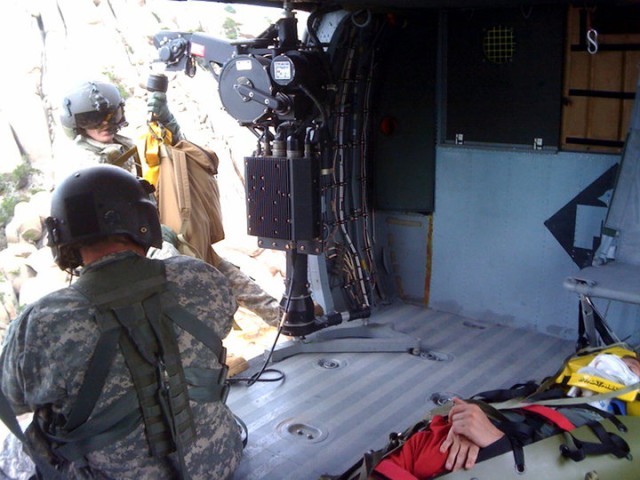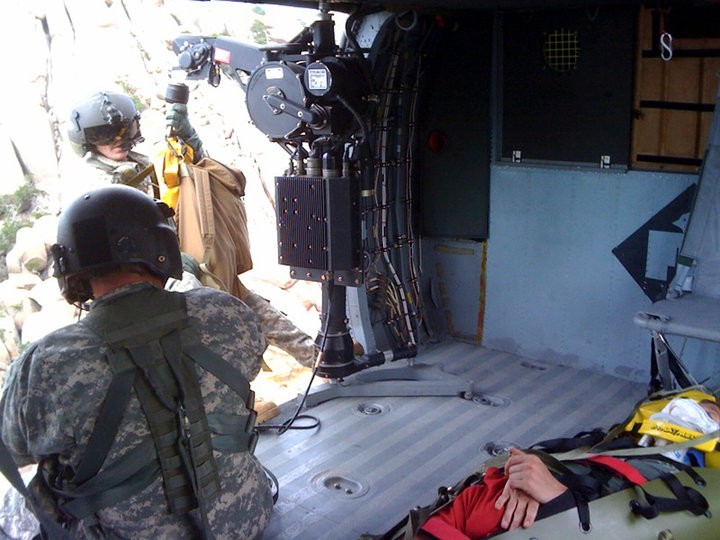Story by Sgt. 1st Class Claudia K. Bullard, Oklahoma National Guard Office of Public Affairs
OKLAHOMA CITY-An Oklahoma National Guard helicopter crew extracted an 18-year-old man from the Wichita Mountains National Wildlife Refuge July 15 after an attempt to remove him from a narrow crevice came to a standstill.
Blackhawk pilot Chief Warrant Officer Michael Taylor, of Noble, said his unit, Detachment 1, Company C, 2 Battalion, 149th General Support Aviation Battalion, received the mission Thursday afternoon after the initial rescue crew had difficulty removing the man from the ravine. He said military equipment and training made it possible to complete the rescue in "a steep, rocky and difficult" environment.
"Civilian air rescue does carry some rescue equipment," said Taylor, "but the main benefit in this mission was the hoist. Without it, it would have been impossible to complete the rescue."
Taylor held the UH-60 Blackhawk at a hover over the site while the crew lowered Sgt. 1st Class John Steele, a medic, down to the canyon wall along with rescue equipment.
Chief Warrant Officer 2 Robert Hernandez, of Nobel, Sgt. David Tillman, of Hennessey, and Sgt. Paul Shook, of Norman, assisted Taylor and Steele.
Clint Wagstaff, Director of Emergency Management for Comanche County, was watching the rescue from the command center two miles from the site. He said the young man and his friends make an annual hike in the wildlife reserve located near Lawton, Okla. This year the hike proved dangerous when the man slipped from the path.
"There was no way to get him out without a four to five mile cross country hike," said Wagstaff, adding that local units from Ft. Sill, Altus Air Force Base, and Sheppard Air Force Base were called first for assistance. The only unit that had the right mix of available equipment, manpower, and training was the Oklahoma National Guard.
Deputy Refuge Manager Ralph Bryant was kneeling beside the patient when the chopper arrived. He called the extraction "very precise".
"The medic landed right at the feet of the patient," said Bryant. "He was very professional and knew exactly what he was doing."
According to Bryant, the man, who was leading the hike, slipped and tumbled approximately 80 feet until his fall was broken by a boulder. He suffered extensive injuries including a fractured skull, broken pelvis, broken ribs and two punctured lungs.
"The slope was nearly 90 degrees," said Bryant. "There was no way to go up or down. We were prepped to go down but it was extremely difficult and could have caused more injury. I really thought he wasn't going to make it," said Bryant.
Taylor, who has worked full-time for the Oklahoma Guard since 2005, said experience in the combat zone and Hurricane Katrina has helped make him proficient when flying rescue missions.
"Our first mission in Afghanistan was an extraction in a very steep valley. Thursday's mission reminded me of that first mission," said Taylor.
"We train for this all of the time. It is important to be familiar with the equipment and the procedure for sending a medic down into a small area."


Social Sharing